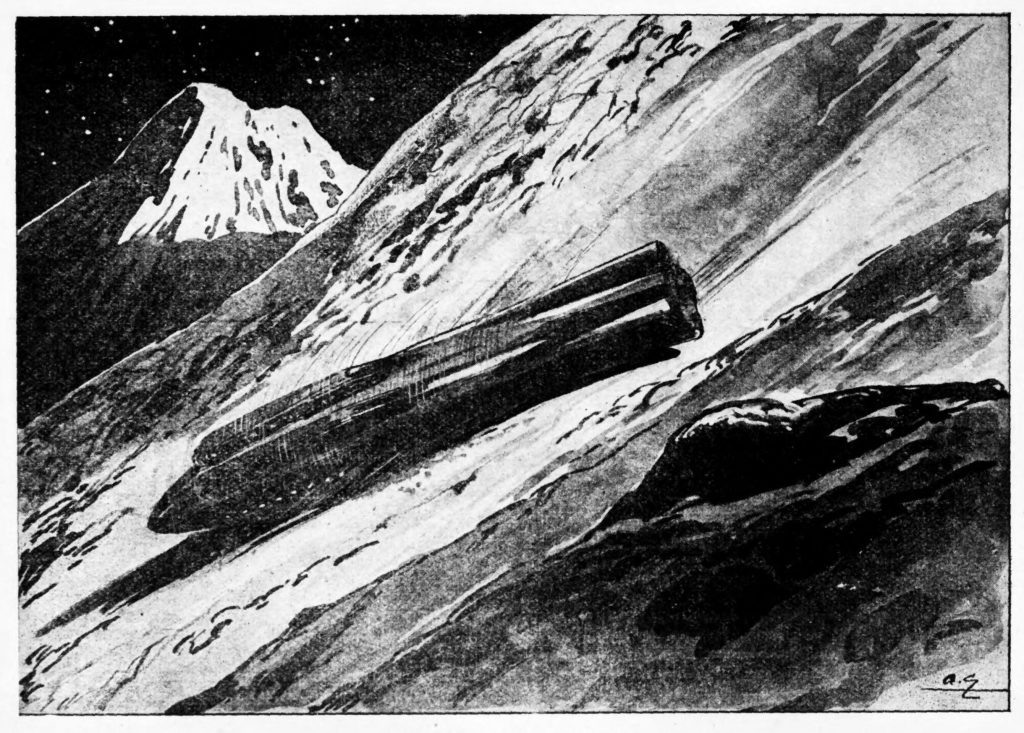A book review written by Kes Lippert based on analysis by Philippe Berthe:
Works of science fiction are vessels for the imagination and a means for authors to tell compelling stories that expand our intellectual horizons and help us dream of new worlds. As we wait for the next launch opportunity for the Artemis mission, it is a nice exercise to reflect on where we have come and read up on where people thought we would be almost a century ago.
In 1933, a French author named Jean Petithuguenin published a science fiction novel titled An International Mission to the Moon, which is available in French for downloading and reading. An English translation is available too at your favourite bookstore. The novel was first published in the Summer of 1926 in the magazine Le Journal de voyages, and then as a book in 1933, making the original available in the public domain.
The novel was ahead of its time in many ways and can be said to be the embodiment of one of the first works of “hard” science fiction, where precise calculations are taken into consideration for plot elements and citations are used to bolster the use of certain methods and technologies.
As humanity prepares to voyage to Earth’s planetary satellite once again with the Artemis mission, the work of Jean Petithuguenin is particularly relevant in the realm of comparison to the modern day. In his time, there was a severe lack of empirical data to back his hypotheses for how human spaceflight would be conducted. Surprisingly, however, many of his calculations are accurate to a large degree. In this piece, we detail Jean’s predictions about modern spaceflight, and compare it to our current means of traveling to space.
For one, Jean accurately predicted that rocket propulsion is the key to modern spaceflight. This is significant compared to earlier works by authors such as Jules Verne, who wrote about shooting men to the Moon using large cannons. However, the team in Jean’s story used solid propellant (think super gunpowder) to launch their rocket to the Moon, which is clearly incorrect given our modern-day knowledge. Additionally, Jean’s mission to the Moon resembles Artemis in the fact that it is a highly collaborative international effort, combining the talents of astronauts from Denmark, France, UK, Germany, US, Italy, Spain, Brazil, Japan and Belgium.
Once outside of Earth’s atmosphere, Jean was correct about several other phenomena likely to be encountered by space explorers. A notable mention is weightlessness, which he correctly deduced as being permanent and present everywhere in space, though he was incorrect in assuming that the mass of the spaceship alone would be enough to keep the astronauts’ feet on the ground. Previous authors such as Jules Verne believed that weightlessness would only be achieved at the point of equilibrium between Earth and the Moon, therefore denoting a significant revolution in thought. Additionally, Jean details several key activities that modern astronauts take part in during their voyages, such as EVA’s (spacewalks) with appropriate attire (space suits to protect from the harsh conditions of the Moon, equipped with radio for communication) and protocol (not everyone should leave the spacecraft at the same time).

Now, in terms of what was not predicted correctly, there are a few items to list, most notably being the ascent into the atmosphere. In the novel, they assume that flying fast into the atmosphere would cause aerodynamic heating and harm to the spacecraft and astronauts. In response, they climb slowly into the sky and accelerate once they approach the vacuum of space. In addition, they initiate the launch from under the sea, in order to use Archimedes’ principle and get extra speed during lift off. Another interesting difference is their lack of knowledge on electronics. The spaceship in the novel is set up like a boat, with a cockpit in the front and a machine room in the back where instructions are given to the crew via acoustic tubes.

On the surface of the Moon itself, Jean believed that there are very steep peaks and valleys, with a rough and rocky landscape underpinning all of it. The astronauts in the story even find signs of plant life such as lichens! Although lichens have not been found on the Moon, it is interesting to note that ESA has proven that lichens can actually survive spaceflight as they toured our planet on the outside of the International Space Station for 18 months!

When it was ultimately time to land for our intrepid adventurers in the book, their ideal landing pad came in the form of forests, which they believed to be ideal for softening the blow, which we now know would not end well if tried with our modern spacecraft.
It is fascinating to get a perspective on how great minds from just a few generations ago thought future space expeditions would operate, and even more exhilarating to know that they got several aspects of spaceflight correct. What did your favourite sci-fi movies of the last decades predict accurately? It’s certainly a good exercise for the imagination and spirit to think of new ways to explore the universe. It would be pretty boring if there was nothing left to invent.
What would Jean Petithuguenin have thought of the Artemis mission, and what would he have to say about future technologies, given a chance to glimpse into the future.
To quote Arthur C. Clarke, “Any sufficiently advanced technology is indistinguishable from magic.”
It is a general tendency of human nature to take for granted what is readily available to us, and it is no different in relation to our modern technology. If we simply look at the world around us, there is plenty of magic left to discover.

 Automated Transfer Vehicle page
Automated Transfer Vehicle page ATV blog archive
ATV blog archive
Discussion: no comments